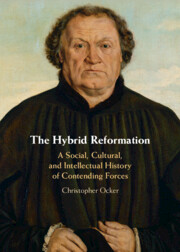8 results

The Hybrid Reformation
- A Social, Cultural, and Intellectual History of Contending Forces
-
- Published online:
- 30 September 2022
- Print publication:
- 22 September 2022
2 - Living between the Old Faith and the New
- from Part I - Indifference and Ambiguity
-
- Book:
- The Hybrid Reformation
- Published online:
- 30 September 2022
- Print publication:
- 22 September 2022, pp 23-43
-
- Chapter
- Export citation
3 - “A Middle Man”
- from Part I - Indifference and Ambiguity
-
- Book:
- The Hybrid Reformation
- Published online:
- 30 September 2022
- Print publication:
- 22 September 2022, pp 44-64
-
- Chapter
- Export citation
1 - After the Peasants’ War
- from Part I - Indifference and Ambiguity
-
- Book:
- The Hybrid Reformation
- Published online:
- 30 September 2022
- Print publication:
- 22 September 2022, pp 3-22
-
- Chapter
- Export citation

Reformation in the Low Countries, 1500-1620
-
- Published online:
- 02 June 2022
- Print publication:
- 09 June 2022
Anabaptist two kingdom dualism: metaphysical grounding for non-violence
-
- Journal:
- Religious Studies / Volume 58 / Issue 3 / September 2022
- Published online by Cambridge University Press:
- 28 May 2021, pp. 598-609
- Print publication:
- September 2022
-
- Article
- Export citation
Part IV - The Religious Question
-
- Book:
- John Calvin in Context
- Published online:
- 14 November 2019
- Print publication:
- 05 December 2019, pp 165-296
-
- Chapter
- Export citation
25 - Polemic’s Purpose
- from Part IV - The Religious Question
-
-
- Book:
- John Calvin in Context
- Published online:
- 14 November 2019
- Print publication:
- 05 December 2019, pp 215-223
-
- Chapter
- Export citation

